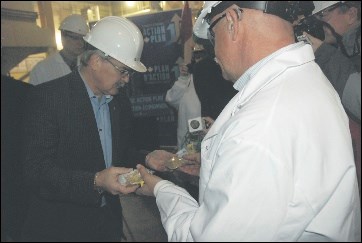Federal agriculture minister Gerry Ritz was among many guests impressed by a revolutionary seed sorting technology now operating in North Battleford.
North Battleford is the only place in North America where a BoMill TriQ seed sorter is being used. The device uses infrared light to analyze wheat, durum or barley seeds for weight, protein, starch or hardness. It then sorts the seeds to meet requirements for food, malt or feed production.
The prototype was being shown in action at the University of Saskatchewan's Canadian Feed Research Centre in North Battleford Wednesday. Ritz and several others were on hand to announce federal funding covering a large portion of the cost for the centre to install the equipment, which has been in operation there for a short while.
"Agriculture in Canada is built on innovation, it's built on sound science and good research, and that's exactly what this type of system feeds into," said Ritz, who is MP for Battlefords-Lloydminster.
Infrared technology was hailed by those at the research centre as something that could revolutionize the way wheat, barley and durum are graded and sorted. Crude protein, moisture and density of grain, particle size and other aspects can be measured by infrared light, it was noted.
Until now, the seeds would be graded and sorted using visual, gravitational and colour-sorting means. Infrared light technology looks at the chemistry of each seed in the sorting process, it was explained by the University of Saskatchewan presenters in attendance.
With infrared technology, not only is there a higher volume sorting capacity, but the subjective visual element would be eliminated, allowing greater opportunity to separate quality No. 1 kernels from lower quality feed kernels.
The federal government contributed $328,000 towards the acquisition of the equipment by the research centre through Western Economic Diversification Canada.
That accounts for roughly 60 per cent of the initial installation and went towards the purchase and evaluation of the equipment. The other funding is made possible to do the experiments and support the graduate students who will be working on the project, through research dollars provided by Alberta Crop Industry Development Fund, Saskatchewan Ministry of Agriculture Research and Development Fund and contributions from the BoMill company.
The Canadian Feed Research Centre is the first installation in North America to have the new Swedish-developed technology, and it is only the fourth place in the world to have it. The other locations for this seed sorter are Australia, Switzerland and Denmark.
The technology was demonstrated Wednesday. It quickly and easily sorted seeds that were collected in small plastic bags.
The infrared technology is able to scan kernels 18 times each as they go through, it was noted. The seed sorter itself is able to process three metric tonnes per hour and has a high-volume sorting capacity that can be ramped up to 30,000 seeds per second.
That can produce increased returns for producers based on more accurate grading of crops. As a result, the potential is there to increase the value of western Canadian grain significantly, ultimately sorting far greater quantities of higher-quality No. 1 kernels that are more valuable on the market than the lower-quality feed grade kernels.
It takes just one per cent of seeds to show signs of sprouting to reduce the grade from No. 1 to feed grade, said Tom Scott, research chair of feed processing technology at the Animal and Poultry Science Department of the University of Saskatchewan,
"In concept, if we could remove those sprouted kernels we could potentially recover over 90 perc ent of the seeds as No. 1, and there is a $100 a tonne difference in value," said Scott.
The cost of the infrared seed sorter is around $400,000, and there are about $100,000 in additional costs that include those for the actual sorting.
According to Scott, on economies of scale, the potential is there to both pay off the machine and make an additional $250,000 after a year in use. That's assuming a recovery of 70 per cent of the feed grade back to No. 1 grade, said Scott.
The prospect of recovering more high-quality kernels and improving the bottom line for grain producers excited those taking in the demonstration.
"It goes beyond visual grading and the grading systems that we're familiar with in western Canada today," noted Ritz, who noted the positive impact on the agricultural economy as a result.
Seeds graded as feed before could be recaptured and "can become malt barley or good milling wheat, or good pasta type durum. So, it's a value-added system that will add value to the tune of several hundred million dollars to grain that is being downgraded now because of the visual grading, where this now takes it to that sound science level and gives you that return on your investment."
The federal government estimates the technology could increase the value of western Canadian grain as much as $320 million a year.
But much work still must be done before the technology comes into general use.
Before that happens, said Ritz, the CFRC will be hard at work adapting the seed sorter to their grain samples and calibrate the equipment for the three common cereal grains: wheat, durum and barley. They will also be testing its capacity to sort out diseased kernels based on low crude protein.
University of Saskatchewan scientists and graduate students will be conducting that wide ranging research. Two graduate students are being funded to carry out some of that work.
Even those in attendance who were not so well versed in agriculture could understand the impact the cutting edge technology could have on the industry. One of them was North Battleford mayor Ian Hamilton, who was impressed by the speed of the machine and the fact it was the only one of its kind in North America.
"This puts North Battleford on the map," said Hamilton of the technology, using the word "awesome" to describe it.




